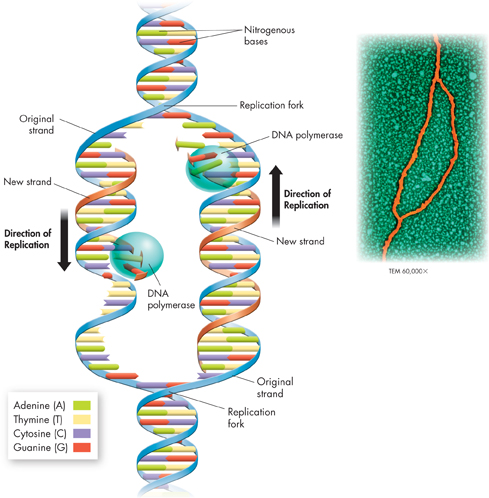The Role of Enzymes DNA replication is carried out by a series of enzymes. These enzymes first “unzip” a molecule of DNA by breaking the hydrogen bonds between base pairs and unwinding the two strands of the molecule. Each strand then serves as a template for the attachment of complementary bases. You may recall that enzymes are proteins with highly specific functions. For this reason, they are often named for the reactions they catalyze. The principal enzyme involved in DNA replication is called DNA polymerase (PAHL ih mur ayz).  DNA polymerase is an enzyme that joins individual nucleotides to produce a new strand of DNA. Besides producing the sugar-phosphate bonds that join nucleotides together, DNA polymerase also “proofreads” each new DNA strand, so that each molecule is a near-perfect copy of the original.
DNA polymerase is an enzyme that joins individual nucleotides to produce a new strand of DNA. Besides producing the sugar-phosphate bonds that join nucleotides together, DNA polymerase also “proofreads” each new DNA strand, so that each molecule is a near-perfect copy of the original.
MYSTERY CLUE

How might UV-induced chemical changes in bases affect the process of DNA replication?

FIGURE 12–8 DNA Replication During DNA replication, the DNA molecule produces two new complementary strands. Each strand of the double helix serves as a template for the new strand. The micrograph shows a pair of replication forks in human DNA. Apply Concepts What makes the new DNA strand complementary to the original strand?
ddTable of Contents
- Formulas and Equations
- Applying Formulas and Equations
- Mean, Median, and Mode
- Estimation
- Using Measurements in Calculations
- Effects of Measurement Errors
- Accuracy
- Precision
- Comparing Accuracy and Precision
- Significant Figures
- Calculating With Significant Figures
- Scientific Notation
- Calculating With Scientific Notation
- Dimensional Analysis
- Applying Dimensional Analysis




